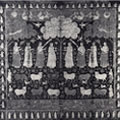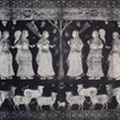 |
|
 |
 |
 |
 |
 |
 |
 |
 |
Hindu Temple Hangings
The two large paintings in this section are cloth temple hangings known as pichhavais (literally, "those which hang at the back"). Intended to be hung behind sculptures of Krishna, an incarnation of the Hindu god Vishnu, both hangings are painted with representations of the theme of Krishna and the female cowherds, known as gopis. An enormously popular theme in Indian literature and art, this motif features Krishna's early life as a cowherd and his magnetic appeal to the women he encounters. Use of temple hangings such as these, probably from Gujarat or the Deccan, developed as part of the evolution of an important sect of Krishna worship known as Vallabha Sampradaya, after the name of the founder, Vallabha (1478-1532). Vallabha advocated absolute devotion (bhakti) to Krishna as the most important mode of religious observance, celebrating the manifestation of Krishna in this physical world. Vallabha's successors instituted a complex calendar of worship to celebrate the life of both Krishna and Vallabha, and its different feasts required different paintings and decorated altars because it was assumed that Krishna always wanted elaborate, luxurious decorations in his shrine. Thus, many pichhavais were produced, both for the sect's temples and for pilgrims who use them in domestic shrines. |
 |
 |
| 1 thru 2 of 2 |
 |
| view text only list |
 |

The Rainy Season |
 |

The Rainy Season |
 |
|
 |